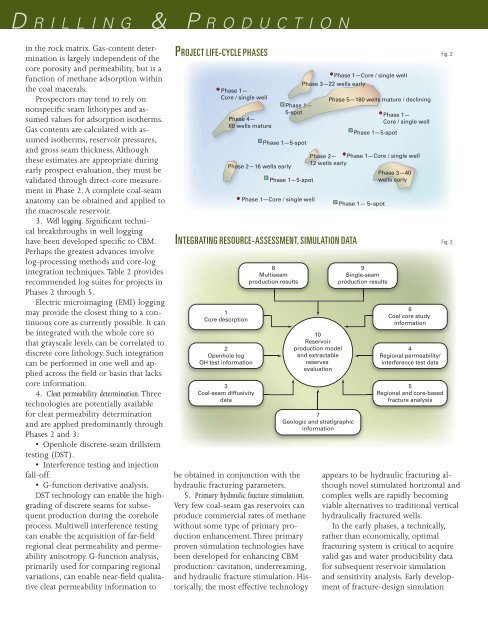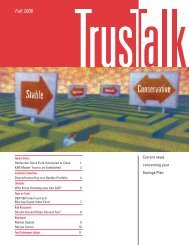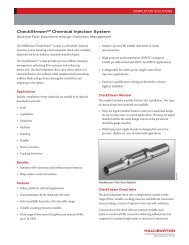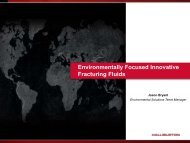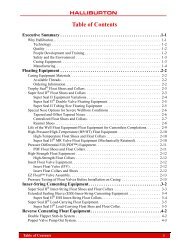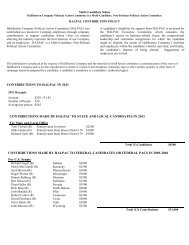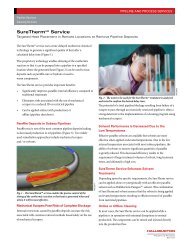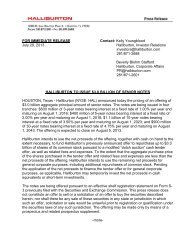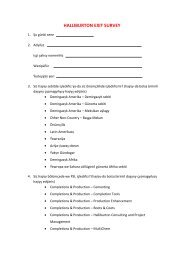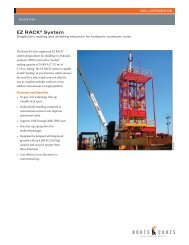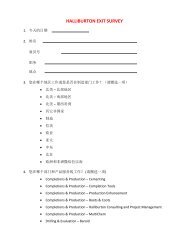Trends In Unconventional Gas - Halliburton
Trends In Unconventional Gas - Halliburton
Trends In Unconventional Gas - Halliburton
You also want an ePaper? Increase the reach of your titles
YUMPU automatically turns print PDFs into web optimized ePapers that Google loves.
D r i l l i n g & Pr o d u c t i o n<br />
in the rock matrix. <strong>Gas</strong>-content determination<br />
is largely independent of the<br />
core porosity and permeability, but is a<br />
function of methane adsorption within<br />
the coal macerals.<br />
Prospectors may tend to rely on<br />
nonspecific seam lithotypes and assumed<br />
values for adsorption isotherms.<br />
<strong>Gas</strong> contents are calculated with assumed<br />
isotherms, reservoir pressures,<br />
and gross seam thickness. Although<br />
these estimates are appropriate during<br />
early prospect evaluation, they must be<br />
validated through direct-core measurement<br />
in Phase 2. A complete coal-seam<br />
anatomy can be obtained and applied to<br />
the macroscale reservoir.<br />
3. Well logging. Significant technical<br />
breakthroughs in well logging<br />
have been developed specific to CBM.<br />
Perhaps the greatest advances involve<br />
log-processing methods and core-log<br />
integration techniques. Table 2 provides<br />
recommended log suites for projects in<br />
Phases 2 through 5.<br />
Electric microimaging (EMI) logging<br />
may provide the closest thing to a continuous<br />
core as currently possible. It can<br />
be integrated with the whole core so<br />
that grayscale levels can be correlated to<br />
discrete core lithology. Such integration<br />
can be performed in one well and applied<br />
across the field or basin that lacks<br />
core information.<br />
4. Cleat permeability determination. Three<br />
technologies are potentially available<br />
for cleat permeability determination<br />
and are applied predominantly through<br />
Phases 2 and 3:<br />
• Openhole discrete-seam drillstem<br />
testing (DST).<br />
• <strong>In</strong>terference testing and injection<br />
fall-off.<br />
• G-function derivative analysis.<br />
DST technology can enable the highgrading<br />
of discrete seams for subsequent<br />
production during the corehole<br />
process. Multiwell interference testing<br />
can enable the acquisition of far-field<br />
regional cleat permeability and permeability<br />
anisotropy. G-function analysis,<br />
primarily used for comparing regional<br />
variations, can enable near-field qualitative<br />
cleat permeability information to<br />
PROJECT LIFE-CYCLE PHASES Fig. 2<br />
Phase 1—<br />
Core / single well<br />
Phase 4—<br />
60 wells mature<br />
Phase 1—<br />
5-spot<br />
Phase 1—5-spot<br />
Phase 1—Core / single well<br />
be obtained in conjunction with the<br />
hydraulic fracturing parameters.<br />
5. Primary hydraulic fracture stimulation.<br />
Very few coal-seam gas reservoirs can<br />
produce commercial rates of methane<br />
without some type of primary production<br />
enhancement. Three primary<br />
proven stimulation technologies have<br />
been developed for enhancing CBM<br />
production: cavitation, underreaming,<br />
and hydraulic fracture stimulation. Historically,<br />
the most effective technology<br />
Phase 1—Core / single well<br />
Phase 3—22 wells early<br />
Phase 5—180 wells mature / declining<br />
Phase 1—5-spot<br />
Phase 2— Phase 1—Core / single well<br />
12 wells early<br />
Phase 2—16 wells early<br />
Phase 3—40<br />
Phase 1—5-spot<br />
wells early<br />
2 x 2<br />
Phase 1— 5–spot<br />
Phase 1—<br />
Core / single well<br />
INTEGRATING RESOURCE-ASSESSMENT, SIMULATION DATA Fig. 3<br />
1<br />
Core desorption<br />
2<br />
Openhole log<br />
OH test information<br />
3<br />
Coal-seam diffusivity<br />
data<br />
8<br />
Multiseam<br />
production results<br />
10<br />
Reservoir<br />
production model<br />
and extractable<br />
reserves<br />
evaluation<br />
7<br />
Geologic and stratigraphic<br />
information<br />
2 x 2.5<br />
9<br />
Single-seam<br />
production results<br />
6<br />
Coal core study<br />
information<br />
4<br />
Regional permeability/<br />
interference test data<br />
5<br />
Regional and core-based<br />
fracture analysis<br />
appears to be hydraulic fracturing although<br />
novel stimulated horizontal and<br />
complex wells are rapidly becoming<br />
viable alternatives to traditional vertical<br />
hydraulically fractured wells.<br />
<strong>In</strong> the early phases, a technically,<br />
rather than economically, optimal<br />
fracturing system is critical to acquire<br />
valid gas and water producibility data<br />
for subsequent reservoir simulation<br />
and sensitivity analysis. Early development<br />
of fracture-design simulation<br />
No. z080121OGJdwy02.eps<br />
No. z080121OGJdwy03.eps


